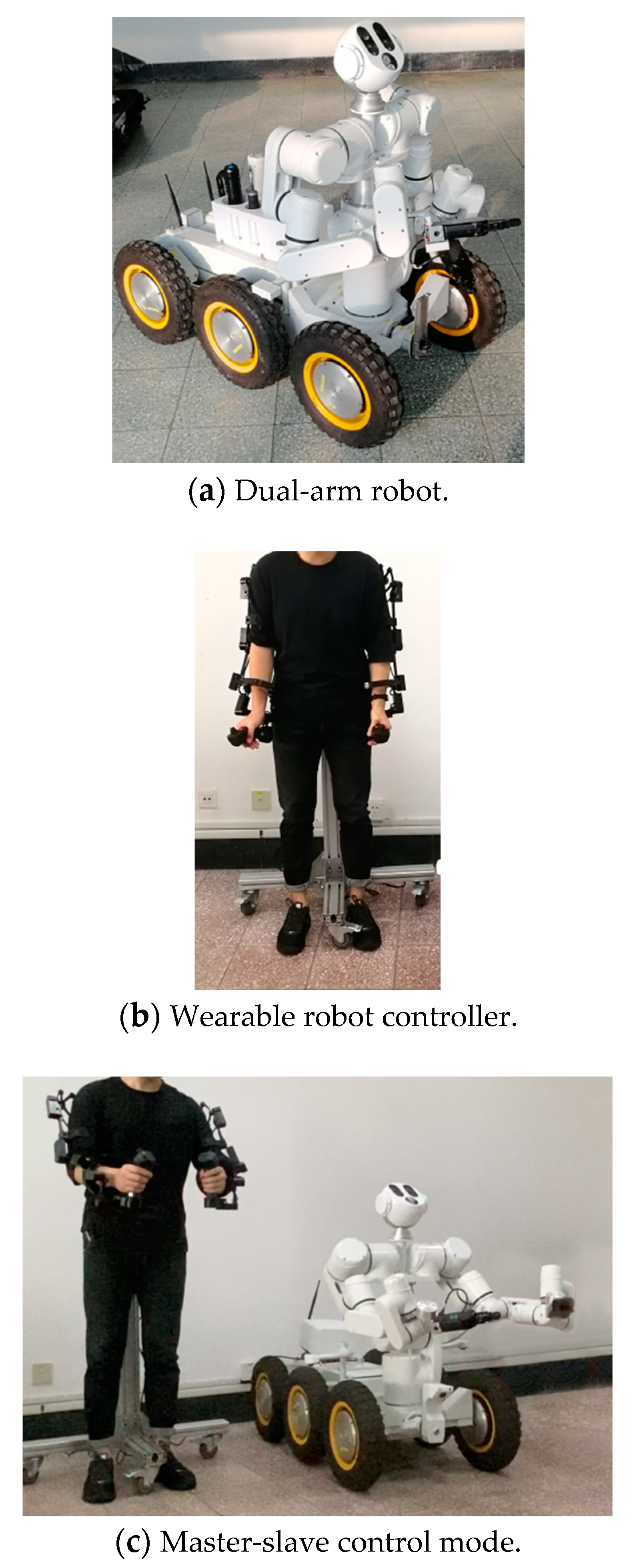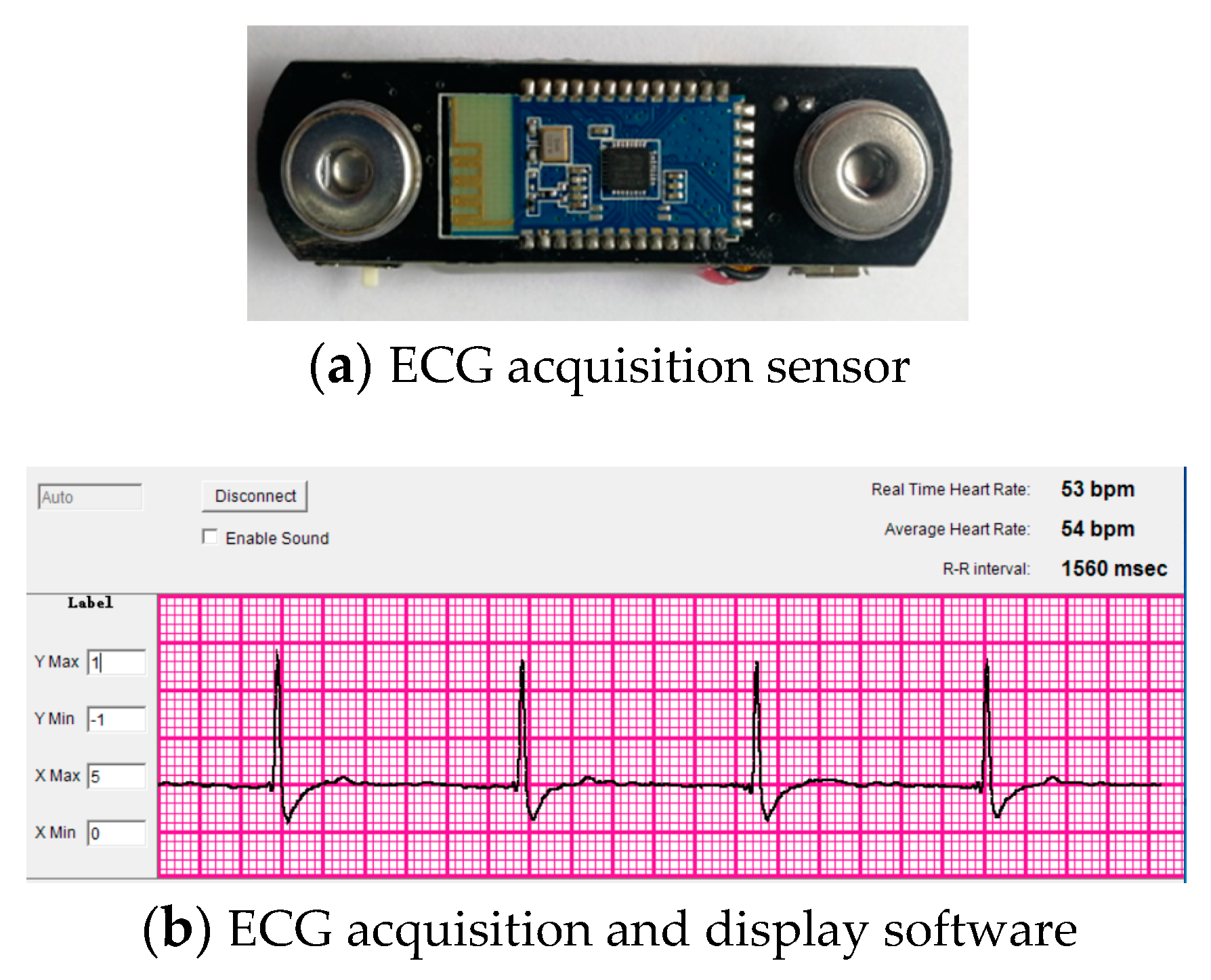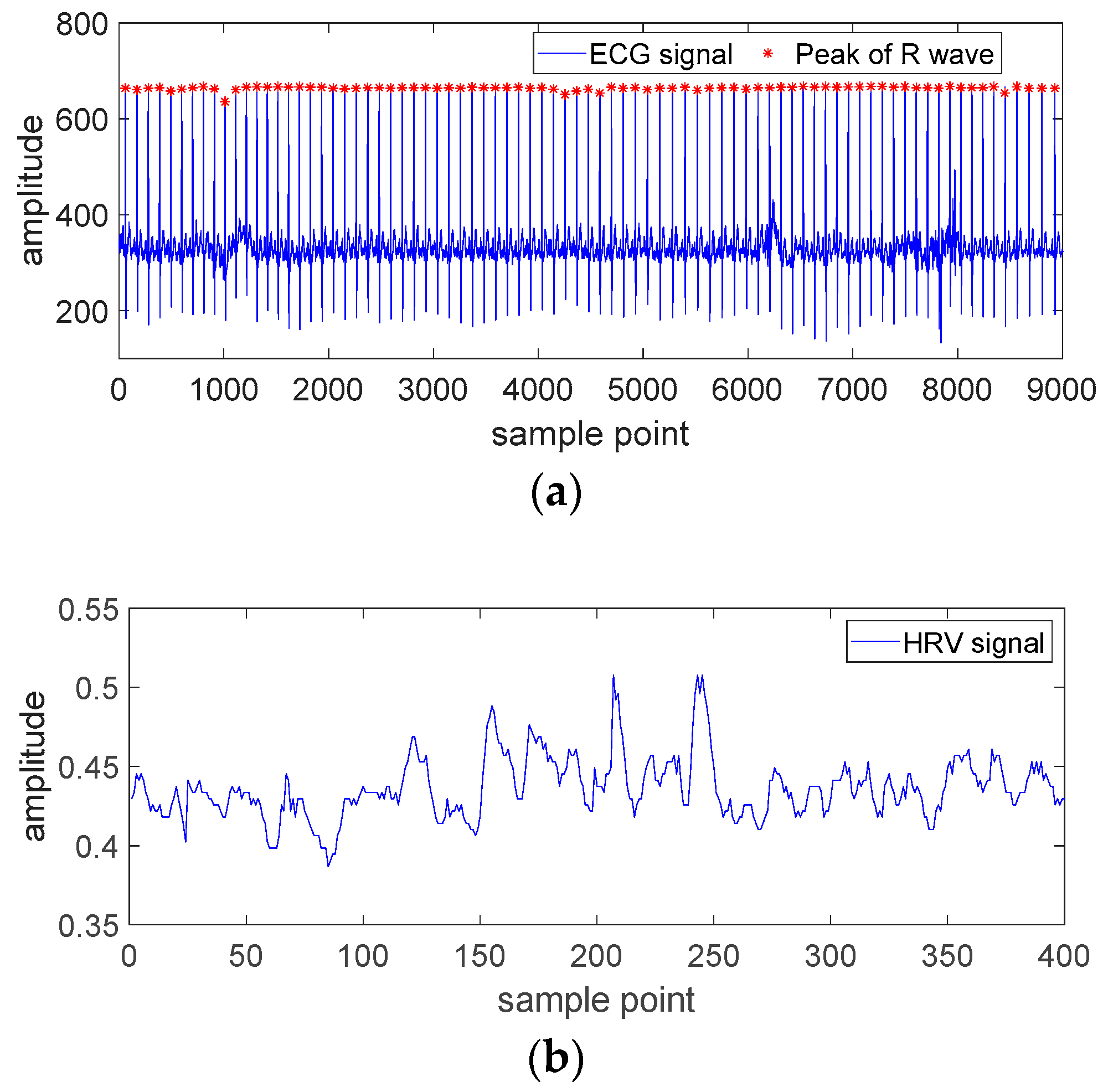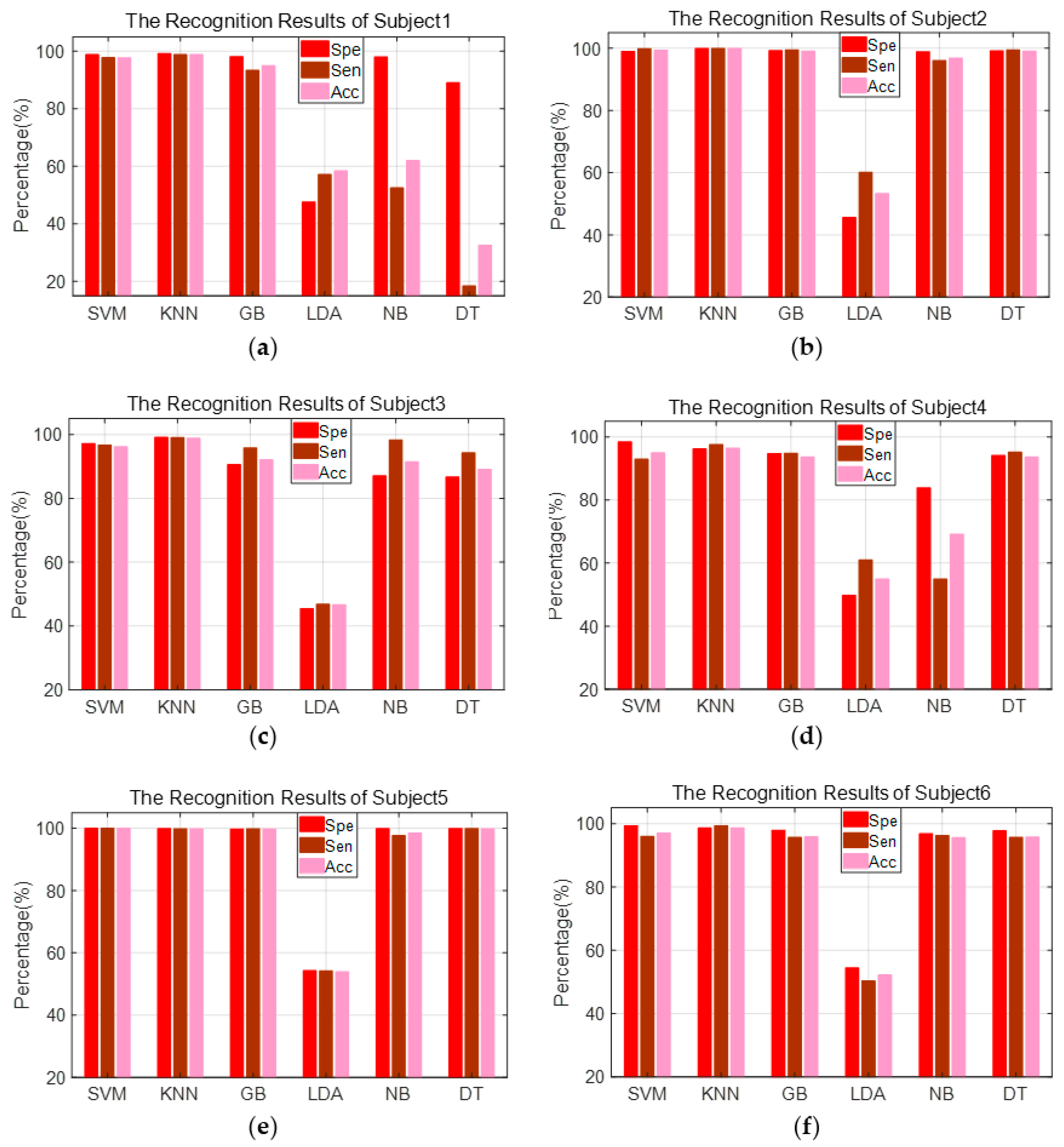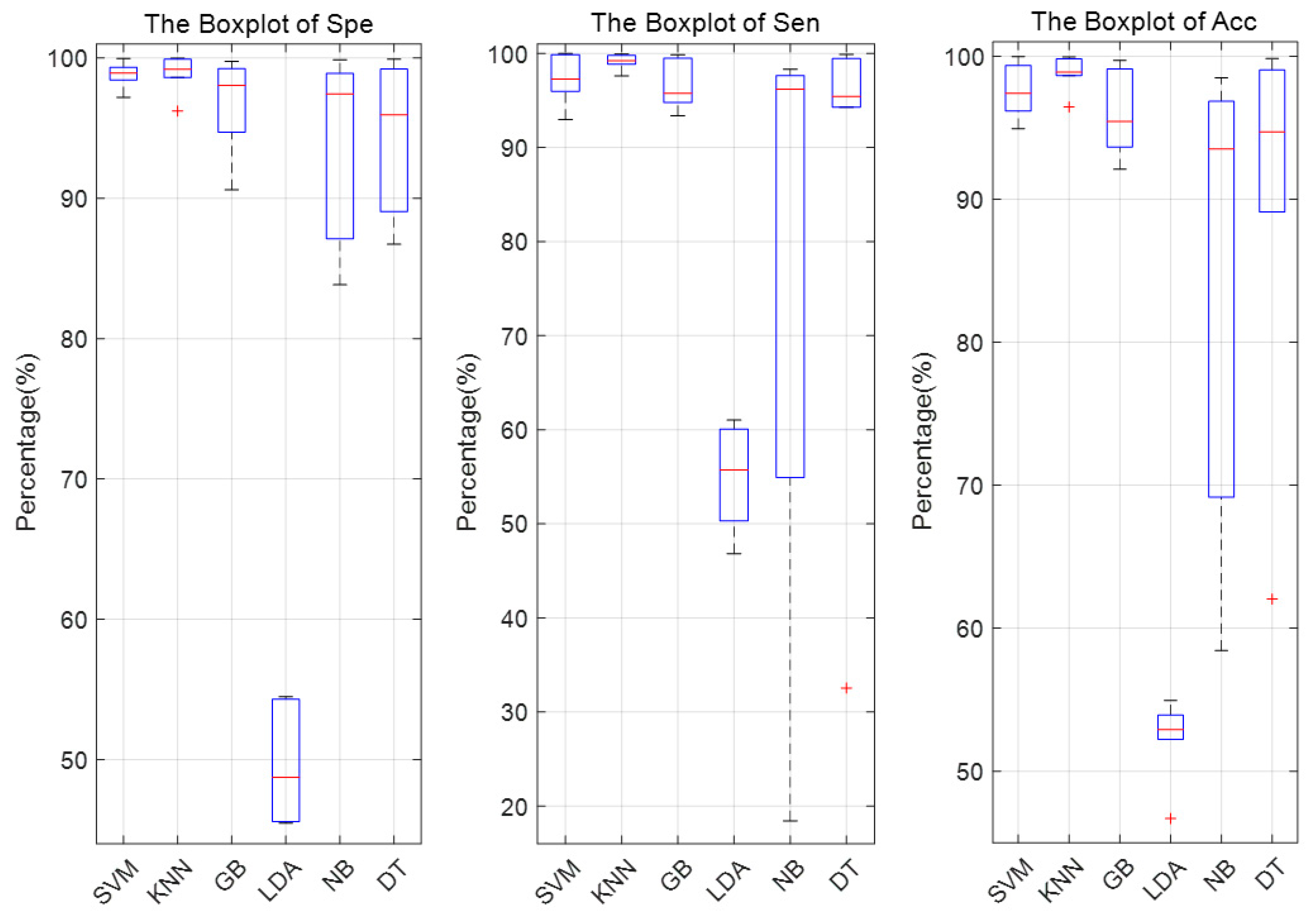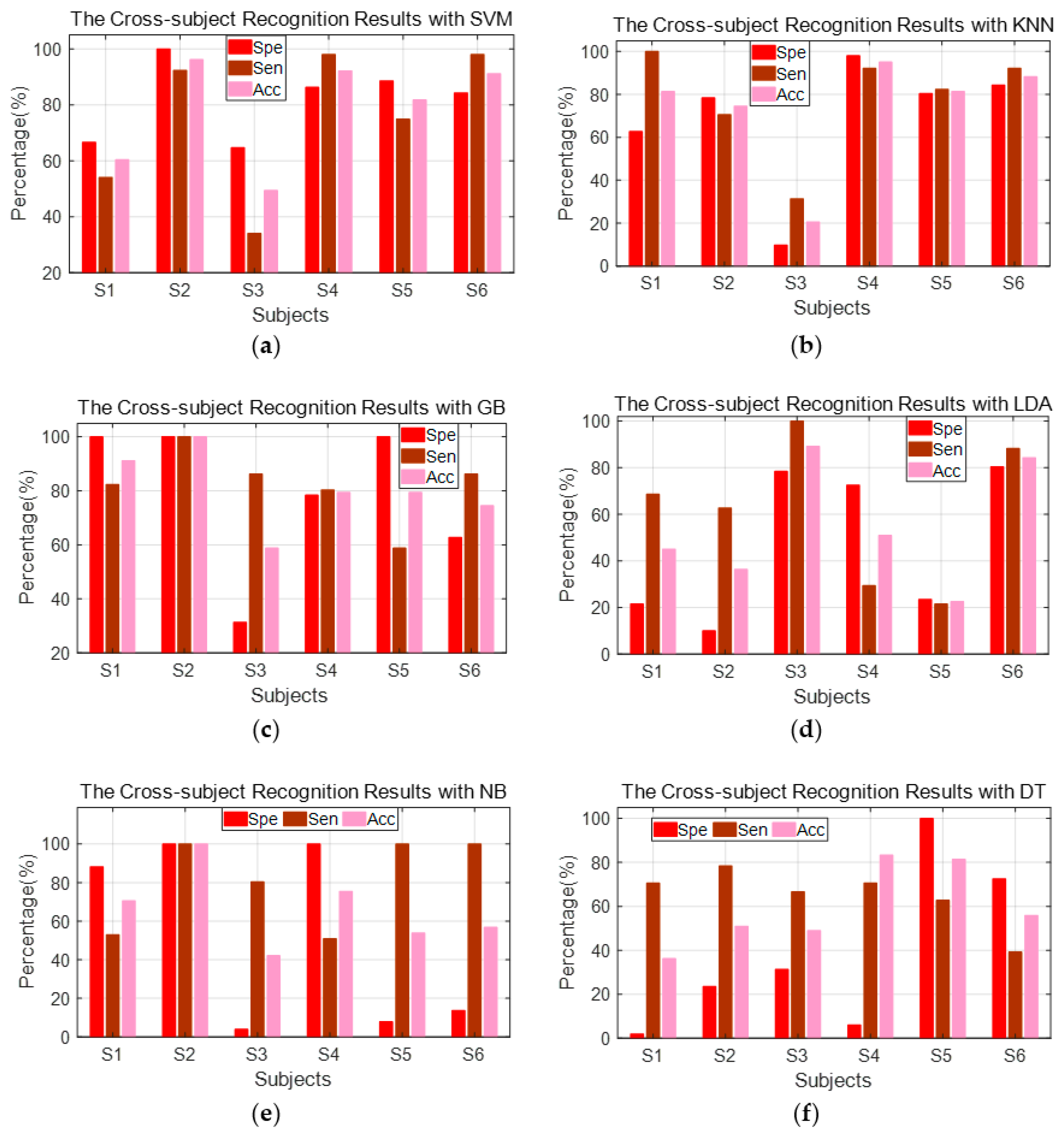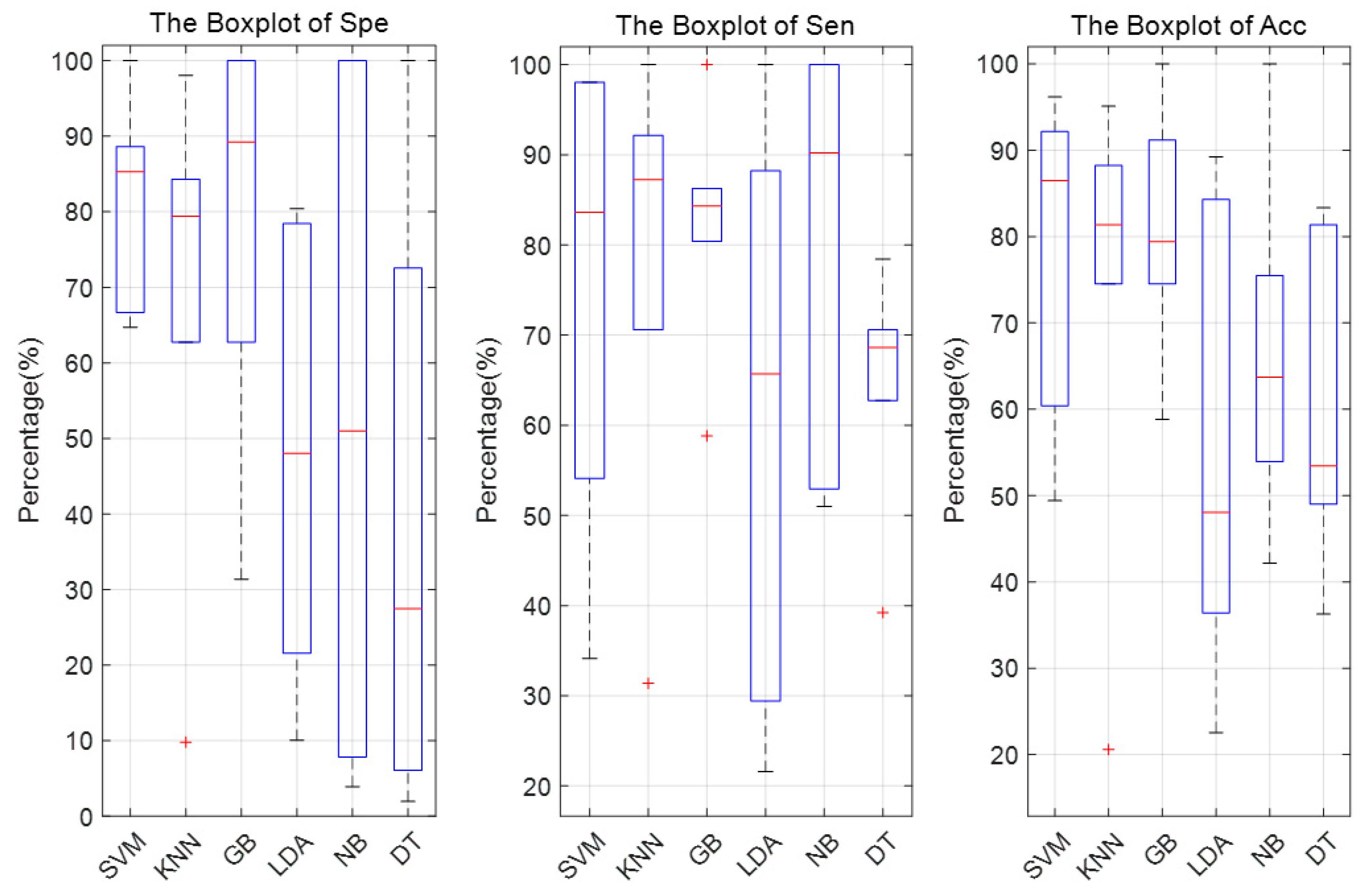1. Introduction
In unstructured environments, robots replace humans to perform some complex tasks, which expends the scope of human work [
1,
2]. The dual-arm robot, a kind of typical robot, has been widely studied [
3,
4]. Dual-arm robots can simulate the movement of two arms of human, making an important step towards humanoid operation. Studies based on dual-arm robots have always moved towards the operation of humanization. In this paper, a dual-arm robot is studied as the operating object, which is controlled by a wearable exoskeleton controller in master-slave mode. The dual-arm robot’s performance is not only limited by the performance of the system, but also related to the current state of the operator closely. Sometimes, a large mental workload can still lead to improper or wrong operation even when the system is stable and the operator has a good sense of presence. Therefore, it is crucial to monitor the mental workload of the operator. On this basis, the human-robot task assignment could be dynamically adjusted based on the mental workload. This kind of research improves human-robot system performance and safety and refine the subjective experience of operators. Therefore, it is of great theoretical significance and practical value to study the mental workload measurement of the operators of dual-arm robots.
In recent years, mental workload has gradually become a hot research topic. The concept was first proposed in the 1940s [
5]; its purpose was to optimize the human–machine system. There are various definitions of mental workload; however, the primary content of the definitions is the relationship between ‘requirement of resources for tasks’ and ‘ability of the operator to provide those resources’ [
6]. In reality, the traditional methods of evaluating mental workload are mainly subjective. However, the main defect of the subjective scale method is the lack of objectivity and continuity of measurement. Undeniably, the evaluation of mental workload by physiological signals, such as electroencephalogram (EEG) [
7,
8], respiration rate (RR) [
9], blood pressure (BP) [
10], skin temperature (ST) [
11], galvanic skin response (GSR) [
12], blink frequency (BF) [
13], and heart rate variability (HRV) [
14], has achieved some progress. Although more effective information can be obtained by using multi-sensors fusion to analyze mental workload, it causes great inconvenience to operators because they have to use a large number of electrodes, sensor units, and so on. HRV is the physiological phenomenon of fluctuation in the time interval between heartbeats. It is the most convenient and common physiological measurement method for mental workload. Thus, in this paper, HRV is studied as a measure of mental workload in human and dual-arm robot interaction.
The traditional mental workload measuring method using HRV is considered to be on the basis of time domain and frequency domain features. About the time domain features, the better performing ones are the standard deviation of the R-R interval (SDNN), the root mean square of the successive R-R interval difference (RMSSD), the proportion of the beats with a successive R-R interval difference exceeding 50 ms (PNN50), and the sum of all R-R intervals divided by the maximum density distribution (HRVTi) [
15,
16]. Moreover, in the frequency domain analysis method, the HRV signal is always decomposed into multi-frequency components. In fact, the power spectral of each frequency component and the sum of power spectral of all frequency bands are regarded as features for mental workload measurement. In detail, these features include power spectrum of very low frequency band (VLF: 0.003–0.040 Hz), low frequency band (LF: 0.04–0.15 Hz), high frequency band (HF: 0.15–0.4 Hz), and total power spectrum (TP: ≤ 0.4 Hz) [
17,
18]. However, the time domain indices cannot show the time-varying characteristics of HRV. Thus, it is limited for the response to the autonomic nervous system. Meanwhile, the frequency domain indices can only provide global frequency information, lacking in coupling information between local and different frequencies. A human body can be abstracted into a complex nonlinear system. Nevertheless, the time domain and frequency domain features of HRV signals are unable to express the nonlinear characteristics of HRV signals completely [
19,
20]. At present, relevant studies have used nonlinear analysis methods to analyze HRV signals for mental workload. Castaldo et al. [
21] extracted the nonlinear features of HRV signals to achieve psychological load measurement analysis while playing games. Specifically, it includes Poincare plot, de-trending fluctuation analysis, recurrence plot, sample entropy, approximate entropy, and Shannon entropy, among others. Tiwari et al. [
22] proposed an improved multi-scale permutation entropy analysis method to measure and analyze HRV signals. Finally, they accomplish the classification of mental workload in the process of MATB. Delliaux et al. [
23] analyzed a variety of nonlinear features of HRV signals through statistical analysis.
However, there is no research on HRV as a measure of mental workload in human and dual-arm robot interaction. In this paper, HRV is studied as a measure of mental workload in human and dual-arm robot interaction. The main contributions of this work are summarized as follows: First, this paper extracts time domain features, frequency domain features, and nonlinear features of HRV signals, exploring the hidden layer of neural activity information deeply. Then, the mapping relationship between the HRV signal and mental workload is analyzed. In addition, models trained with the same subject data and across different subjects are researched, respectively.
The rest of the paper is structured as follows: In
Section 2, the process of ECG data acquisition is described and the HRV signal extraction algorithm is presented. Additionally, the features extraction method is presented.
Section 3 shows the experimental results, which reflect the statistical analysis of features and mental workload measures. The discussion of results are present in
Section 4. In
Section 5, the conclusion of this paper is presented.
3. Results
Using the time domain, frequency domain and nonlinear analysis method above, the HRV signals are analyzed when the subjects are in performing the task and relaxing state, respectively. Firstly, a t-test is used and the statistical significance of the extracted time domain, frequency domain, and nonlinear features are analyzed. Then, the features with statistical differences are selected for the classification of mental workload. Furthermore, for the sake of excluding the effects of classifier performance differences, six classifier algorithms are selected to identify and classify the mental workload, which are Support Vector Machine (SVM), Linear Discriminant Analysis (LDA), K-Nearest Neighbor (KNN), Decision Tree (DT), Gentle Boost (GB), and Naive Bayes (NB). The default parameters are selected as the parameters of the six classification algorithms in this paper. In addition, the HRV signals under different mental workload are divided into testing set and training set based on 10-fold cross-validation. Furthermore, the performance of mental workload levels are classified and evaluated by three indicators, which are defined as follows:
where
TP is defined as those samples in which the predicted and actual values are both positive.
FP is defined as those samples that are classified as positive samples, but they are actually negative samples.
FN is defined as those samples that are predicted to be negative samples, but their actual values are positive. Additionally,
TN is defined as the actual values of samples that are positive but that are predicted to be negative. In this paper, the performing task state samples are defined as positive samples and the relaxing state samples are defined as negative samples.
3.1. Statistical Analysis of Features
3.1.1. Statistical Difference Analysis of Features from the Same Subject
Using the t-test, the statistical differences of time domain, frequency domain, and nonlinear features are analyzed in the same subject at different states (performing task state and relaxing state). Defining the sample set of subject1’s performing task state as S1-M, sample set of subject1’s relaxing state as S1-R. Meanwhile, the sample set of subject2′s, subject3’s, subject4’s, subject5’s, and subject6’s different lengths of time is defined by this rule.
Table 4 shows the statistical differences among 6 subjects. Moreover, each subject has two different mental workload states (performing task state and relaxing state). In detail,
Table 4 shows the statistical differences of time domain, frequency domain and nonlinear features. It can be seen that there are total 87 features that are most significant differences (
p < 0.001) between two different mental workload states from
Table 4.
Among them, subject1 has 20 features with most significant differences (p < 0.001), which consist of six time domain features, 10 frequency domain features, and four nonlinear features.
Subject2 has 13 features with most significant differences (p < 0.001), which consist of six time domain features, five frequency domain features, and two nonlinear features.
Subject3 has 15 features with most significant differences (p < 0.001), which consist of six time domain features, seven frequency domain features, and two nonlinear features.
Subject4 has 16 features with most significant differences (p < 0.001), which consist of five time domain features, seven frequency domain features, and four nonlinear features.
Subject5 has nine features with most significant differences (p < 0.001), which consist of five time domain features, and four frequency domain features.
Subject6 has 14 features with most significant differences (p < 0.001), which consist of five time domain features, five frequency domain features, and four nonlinear features.
3.1.2. Statistical difference analysis of features cross the different subject
Using the t-test, the statistical differences of time domain, frequency domain, and nonlinear features are analyzed cross the different subject at different states (perform task state and relaxed state). The sample set of subject1’s, subject2’s, subject3’s, subject4’s, subject5’s, and subject6’s performing task state is defined as the CM group and the sample set of subject1’s–subject6’s in the relaxing state is defined as CR group.
Table 5 shows the statistical differences between two different mental workload state sample sets.
Table 5 shows time domain and nonlinear features and
Table 5 shows frequency domain features. It can be seen from
Table 5 that there are 18 most significant difference (
p < 0.001) features in the two groups of CM and CR.
3.2. Mental Workload Classification Based on the Same Subject
The classification and identification of mental workload are carried out on six subjects, respectively. Additionally, the features with statistical differences are selected for the classification of mental workload. The sample datasets for each experiment are divided into training set and testing set. In order to verify the classification performance of features, a total of six classification algorithms are used in this paper so each subject has trained six models. In this paper, there are six experimental subjects and 6 × 6 = 36 models are trained. The average value of 10-fold cross-validation is used as the final experimental result. In order to ensure the reliability of the experimental results, the 10-fold cross-validation is repeated 100 times.
Figure 6 and
Table 6 are the classification results for each subject using different classifiers, as can be seen from
Figure 6a and
Table 6. SVM, KNN, and GB show better classification results for subject1. In addition, the KNN classification algorithm shows the highest Spe, Sen, and Acc: 99.26%, 98.86%, and 98.91%, respectively. It can be seen from
Figure 6b and
Table 6 that SVM, KNN GB, NB, and DT show better classification results for subject2. In addition, the KNN classification algorithm shows the highest Spe, Sen, and Acc: 99.99%, 98.94%, and 99.95%, respectively. It can be seen from
Figure 6c and
Table 6, for the subject3. LDA shows the worst classification effect and the KNN classification algorithm shows the highest Spe, Sen, and Acc: 99.15%, 99.07%, and 98.84%, respectively. As
Figure 6d and
Table 6 demonstrate, SVM, KNN, GB, and DT show better classification results for subject4. The SVM classification algorithm shows the highest Spe (98.43%) and KNN classification algorithm shows the highest Sen and Acc: 97.61% and 96.45%, respectively. As can be seen from
Figure 6e and
Table 6, for the subject5, all five classification algorithms, except LDA, show good performance of classification. The SVM classification algorithm shows the best Spe, Sen, and Acc: 99.97%, 99.99%, and 99.97%, respectively. It can be seen from
Figure 6f and
Table 6 that the KNN classification algorithm shows the highest Spe, Sen, and Acc: 98.61%, 99.34%, and 98.64%, respectively.
Finally, the Spe, Sen, and Acc of the six subjects under different classification are presented in box plots (
Figure 7). Box plots not only show the average values, but the distribution of the computed values can also be given. Additionally, the abnormal values are given by red points. As can be seen from the figure, while using the KNN classifier, all 6 subjects exhibit highest Spe, Sen, and Acc, with the least overall discreteness. However, in Spe and Acc, outliers appear. While using the SVM classifier, the six subjects perform higher Spe, Sen, and Acc, and the data are less discrete. Comparing with KNN and SVM classifiers, the GB classifier shows a large degree of discreteness but the classification results are stable. The performance of classification of the DT classifier is slightly worse than GB. The classification results of LDA and NB classifiers are the least satisfactory, with Spe, Sen, and Acc of LDA being lower, while the Spe, Sen, and Acc of NB classifier are the most discrete.
3.3. Mental Workload Classification Cross Subject
In this sub-section, the performance differences of cross-subject mental workload classification are analyzed. The features with statistical differences are selected for the classification of mental workload. Samples of five subjects are used as a training set and samples of the leave-out subject who is not involved in the training are used as the testing set. Since there are six subjects, the validation process is performed six times.
Figure 8 and
Table 7 are cross-subject classification results using different classifiers. As can be seen from
Figure 8 and
Table 7, for subject1, the KNN classification algorithm shows the highest Sen (100%), and the GB method shows the highest Spe (100%) and Acc (91.18%). For subject2, SVM and GB methods show the highest Spe (100%). At the same time, the GB method also shows the highest Spe (100%) and Acc (100%). For subject3, the LDA classification algorithm shows the best classification performance. The Spe, Sen, and Acc are 78.43%, 100.00%, and 89.22%, respectively. For subject4, SVM shows the highest Sen (98.43%). The KNN method shows the highest Acc (95.1%). Te NB method shows the highest Spe (100%). For subject5, SVM shows the highest Acc (81.76%). GB and DT show the highest Spe (100%) and the NB method shows the highest Spe (100%). For subject6, both SVM and KNN methods show the highest Spe (84.31%). SVM shows the best Acc (91.18%) and the NB method shows the highest Sen (100%).
Finally, the results of cross-subject classification under different classifiers are presented in box plots (
Figure 9). As can be seen from the figure, there are higher maximums of Spe, Sen, and Acc regardless of the classifier used. However, the figure also shows a more discrete distribution result and the red points represent abnormal values. The difference between the maximum and minimum values is large. In addition, for each subject, there is a classifier that achieves better classification results.
4. Discussion
To the best of our knowledge, this is the first work to measure the operator’s mental workload in human and dual-arm robot interaction process based on wearable exoskeleton controller. At present, many of the studies on mental workload are aimed at the n-back paradigm, simulated driving scenarios, and so on. In the process of interaction between human and dual-arm robot of this paper, the operator adopts the wearable controller. Additionally, the two arms of the dual-arm robot imitate the arms of human. This control mode of master-slave aims to reduce the operator’s burden in the process of human and dual-arm robot interaction as much as possible. In addition, this control mode also excludes the operator’s limb coordination ability differences, which significantly focuses the operator on the task. The study of mental workload in the process of human and dual-arm robot interaction has not been found. In addition, there is no corresponding public datasets. Thus, in this paper, the ECG signal data is collected. According to the ECG signals, the HRV for analysis is extracted.
Studies have shown that a stress response occurs [
29] when the mental workload of the human increases. First, the sympathetic nervous system will be activated. Then the entire nervous system will respond to the increase of mental workload and improve human alertness. Furthermore, blood is transferred from the internal organs and skin to the skeletal muscles. Then the heart rate and heart contraction increase rapidly. These changes allow the body to accumulate large amounts of energy in a short period of time to prepare for external threats. Furthermore, the HRV signal contains information about the regulation of the cardiovascular system by body fluid factors, which can reflect fluctuations of the autonomic nervous system. Therefore, it is feasible to use the HRV signal for mental workload analysis.
More specifically, the existing studies show that the aTotal feature reflects the whole activity of the autonomic nervous system. LF-relative features are thought to be associated with sympathetic activity. HF-relative features are thought to have correlation between the parasympathetic activity. The physiological significance of the VLF-relative features have been identified with long-period rhythms. The relationship between LF components and HF components (LF/HF) is an important indicator of the sympathetic and parasympathetic balance in the body [
30,
31]. The SDNN index and HRVTi feature are believed to primarily measure autonomic influence on HRV [
32]. Both RMSSD and PNN50 reflect parasympathetic (vagal) activity. Nonlinear features represent the fluctuation characteristics of the autonomic nervous system [
33].
In this paper, the time domain features, frequency domain features, and nonlinear features between two mental workload states of the same subject or across different subjects, most features show statistical differences. Only individual features do not show statistical differences, which may be due to personalized differences between subjects. This does not affect the classification of the two mental workload states. Firstly, this paper analyzes the different mental workload states of the same subject. The results show that, for subject1–subject6, the highest Acc are 98.91% (KNN), 99.95% (KNN), 98.84% (KNN), 96.45% (KNN), 99.97% (SVM), and 98.64% (KNN), respectively. The KNN classifier has the highest average recognition accuracy (98.77%) when using the same classifier to identify six subjects separately. The SVM and GB classifiers also show good classification, with the Acc being 97.54% and 95.90%, respectively. None of the remaining three classifiers (LDA, NB, DT) have a classification accuracy rate of more than 90%. Therefore, the KNN algorithm is more suitable for the human and dual-arm robot interaction, using the sample data training model of the same subject and classifying the mental workload of the subject. Then, the different mental workload states cross-subject are classified. The results show that, for subject1–subject6, the highest Acc are 91.18% (GB), 100% (GB), 89.22% (LDA), 95.10% (KNN), 81.76% (SVM), and 91.18% (SVM). Thus, the average classification accuracy of the six subjects classifying using different classifiers is 91.41%. In the case of using the same classifier for the six subjects, the average accuracy of cross-subject identification is 80.56% (GB). Additionally, SVM and KNN also show good classification results, with classification accuracy of 78.51% and 73.53%, respectively. When identifying across subjects, each subject has a classifier that makes it better classified. Therefore, in the future, multiple classifiers should be considered for use and use the voting method to select the best classifier’s classification results.
The analysis of mental workload is related to specific tasks and the study of mental workload in the process of master-to-slave interaction between a wearable controller and a dual-arm robot have not been reported. Therefore, this paper chooses to compare the studies related to mental workload or stress in other scenarios. In [
34], a pilot study is conducted on whether machine learning can predict stress decrease after relaxation on the basis of a wearable sensor. The status before and after relaxation is classified using the ECG and GSR signals for 79.2% classification accuracy. In [
35], detection of drivers’ anxiety based on physiological signals is studied. The results show that classification on the basis of EEG alone shows the best accuracy, it is 77.01%. In [
36], the cross-subject mental workload classification is studied on the basis of kernel spectral regression and transfer learning techniques. An average Acc of 72.66% is obtained for six subjects, the Acc of six subjects are 73.15%, 77.32%, 78.63%, 65.40%, 71.08%, and 70.36%, respectively. In [
37], using wearable sensors, the mental workload of human and robot collaboration is analyzed. However, it is only the statistical analysis of HRV signals in different mental workload states. In addition, there is no study of classification and identification. In this paper, the data of two different mental workload states are collected and 20 kinds of HRV features are extracted. Then, the statistical significance of HRV signal features are analyzed in different states. The features with statistical differences (
p < 0.05) are selected for the identification and analysis of mental workload. Models trained with the same subject data and models trained across different subjects all obtained higher Acc compared with [
34,
35,
36,
37].
In addition, in this paper, the heart beat data collection device is a custom one. Its functionality can be modified based on demand. Furthermore, it is cheap. However, with the rapid development of consumer electronics devices, most of the existing smart watches have heart beat monitoring capabilities. This will be more conducive to long-term detection. Thus, in the future, smart watches will be considered as the heart beat data collection device for research.
5. Conclusions
A human remote-controlled robot performs complex or dangerous tasks in unstructured environments, which expends the scope of human work. In the process of completing the tasks, the mental workload of the operator will change based on the different tasks of the robot. However, too much mental workload will not only affect the robot’s working efficiency and safety, but also impact human physical and mental health. In order to assess the mental workload during human interaction with a dual-arm robot, in this paper, HRV is the measure that is studied. Firstly, the ECG signals of two kinds of mental workload states (performing task state and relaxing state) are collected. The ECG signals are collected from six subjects based on a custom device. Based on the ECG signal, the HRV signal is obtained. Then, 20 kinds of HRV features (time domain, frequency domain, and nonlinear features) are extracted. Finally, six different classifications are used to mental workload classification. The results are that, firstly, using each subject’s HRV signal training model, the subject’s mental workload is classified. The average classification accuracy of 98.77% is obtained using the KNN method. Then, using the HRV signal of five subjects for training, and the remaining one subject for testing, the GB method can obtain the highest average classification accuracy, with the average classification accuracy of six subjects being 80.56%. This study has demonstrated that the HRV can be used to measure the mental workload during human interaction with a dual-arm robot.

